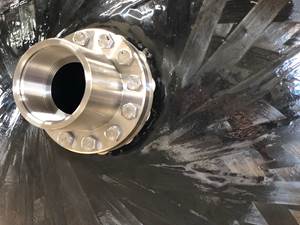Foamed plastics are well suited for CFRP core applications
CAMX 2025: Sekisui Kasei USA presents ST-Eleveat RNW E foamed plastic and ST-Foamac rigid foam board products designed to support composite core needs.
Share
Source | Sekisui Kasei USA
(Mountain Pleasant, Tenn., U.S.), a subsidiary of Sekisui Kasei Co. Ltd., is presenting some of its finished foam products including ST-Eleveat RNW E and ST-Foamac. Sekisui Kasei develops and manufactures core materials specifically designed for carbon fiber-reinforced polymer (CFRP) applications. Its operations span the U.S., Japan and Europe, actively engaged in advancing its materials on a global scale.
ST-Eleveat RNW E foamed plastic is made from PET resin and is available in two forms: beads type (contains 30% recycled content) and sheet type (contains 75% recycled content). This product can be molded into the desired shape using tooling, similar to EPS products. Sekisui Kasei explains that this reduces machining processes and enables the company to mass produce the materials for CFRP applications as a core material.
ST-Eleveat RNW E is environmentally friendly, heat-resistant and 80-90% lighter compared to nonfoamed plastic molded products. It is available in densities 150-300 g/L, with low-density grades currently under development. Bead size ranges from 2.3-2.7 mm. Applications include automotive and transportation, aircraft, marine, electronic devices and CFRP/GFRP foam core sandwich structures.
ST-Foamac is a white rigid foam board made by foaming rigid acrylic resin. It can be used as composite core for buildings and construction, panels, vessels/vehicles and more. This range of applications has also been extended to CFRP core materials.
ST-Foamac is available in two grades depending on heat-resistance needs — S grade at 115℃ (239℉) and HR grade at 180℃ (338℉). Compared to rigid foams of the same density, the material has a higher resistance to tension, bending and compression. It also has good workability. Grades include S #1000 (110 kg/m3), S #1500 (80 kg/m3), S #2000 (56 kg/m3) and HR #1000 (110 kg/m3).
Sekisui Kasei’s mission is to go beyond simply meeting customer requirements. Its team works closely with partners to tailor material solutions that address both performance and processing needs.
Related Content
-
Infinite Composites: Type V tanks for space, hydrogen, automotive and more
After a decade of proving its linerless, weight-saving composite tanks with NASA and more than 30 aerospace companies, this CryoSphere pioneer is scaling for growth in commercial space and sustainable transportation on Earth.
-
Plant tour: Teijin Carbon America Inc., Greenwood, S.C., U.S.
In 2018, Teijin broke ground on a facility that is reportedly the largest capacity carbon fiber line currently in existence. The line has been fully functional for nearly two years and has plenty of room for expansion.
-
Welding is not bonding
Discussion of the issues in our understanding of thermoplastic composite welded structures and certification of the latest materials and welding technologies for future airframes.
Related Content
Infinite Composites: Type V tanks for space, hydrogen, automotive and more
After a decade of proving its linerless, weight-saving composite tanks with NASA and more than 30 aerospace companies, this CryoSphere pioneer is scaling for growth in commercial space and sustainable transportation on Earth.
Read MorePlant tour: Teijin Carbon America Inc., Greenwood, S.C., U.S.
In 2018, Teijin broke ground on a facility that is reportedly the largest capacity carbon fiber line currently in existence. The line has been fully functional for nearly two years and has plenty of room for expansion.
Read MoreWelding is not bonding
Discussion of the issues in our understanding of thermoplastic composite welded structures and certification of the latest materials and welding technologies for future airframes.
Read MoreSulapac introduces Sulapac Flow 1.7 to replace PLA, ABS and PP in FDM, FGF
Available as filament and granules for extrusion, new wood composite matches properties yet is compostable, eliminates microplastics and reduces carbon footprint.
Read MoreRead Next
Ultrasonic welding for in-space manufacturing of CFRTP
Agile Ultrasonics and NASA trial robotic-compatible carbon fiber-reinforced thermoplastic ultrasonic welding technology for space structures.
Read MoreCutting 100 pounds, certification time for the X-59 nose cone
Swift Engineering used HyperX software to remove 100 pounds from 38-foot graphite/epoxy cored nose cone for X-59 supersonic aircraft.
Read MoreScaling up, optimizing the flax fiber composite camper
Greenlander’s Sherpa RV cab, which is largely constructed from flax fiber/bio-epoxy sandwich panels, nears commercial production readiness and next-generation scale-up.
Read More









